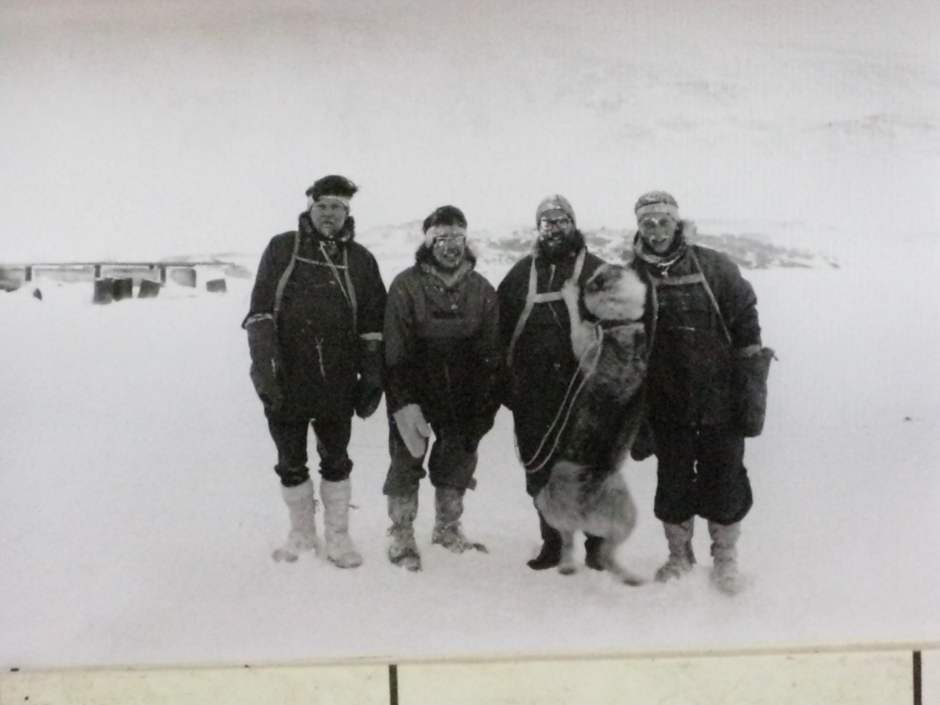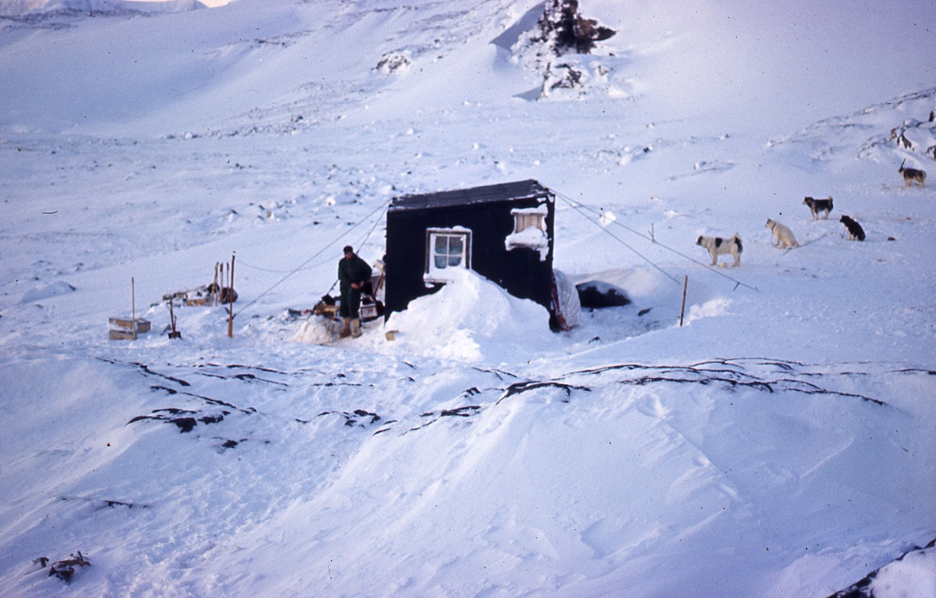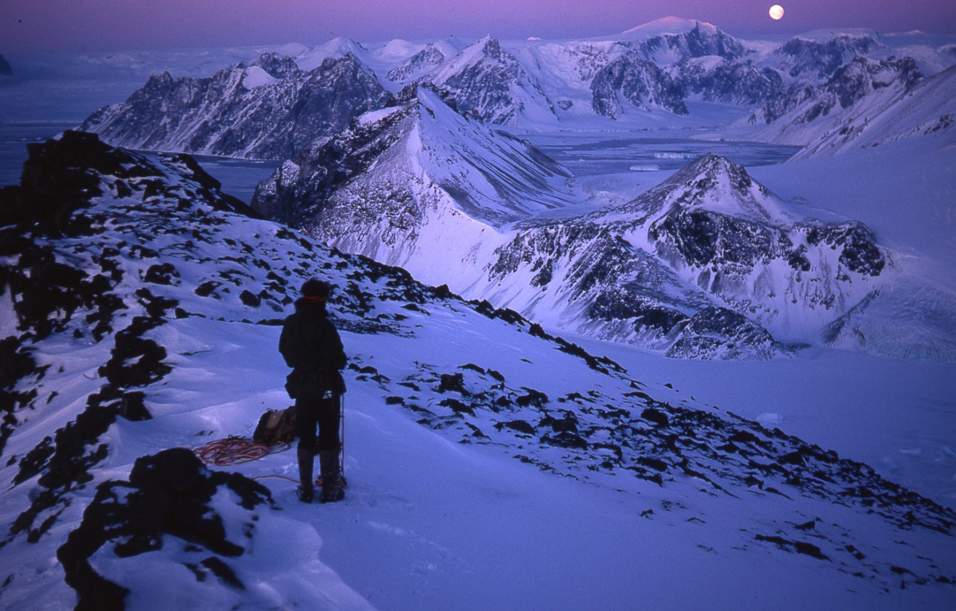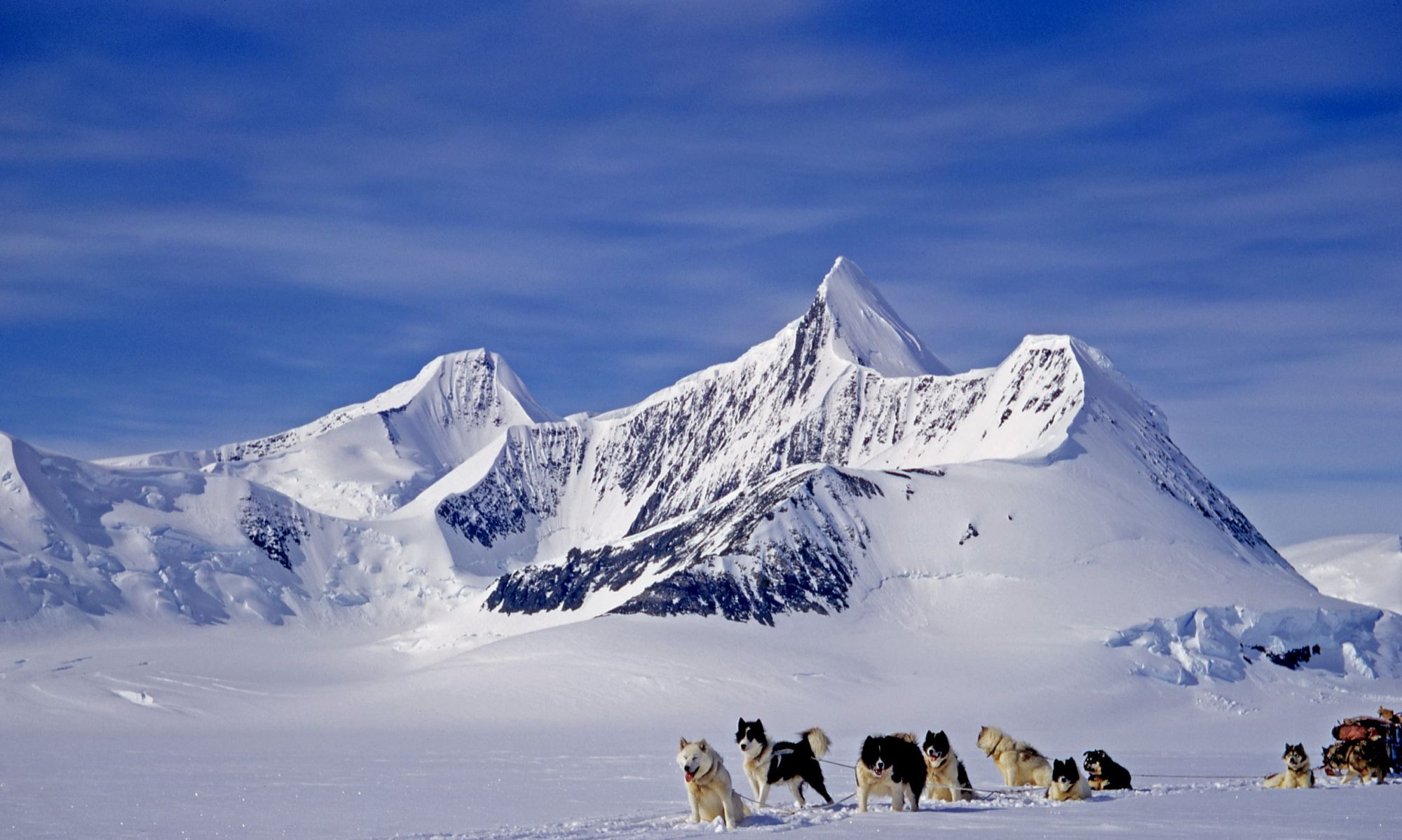1969

our base Commander, Chris Madders the radio operator and Derick Postlethwaite were all leaving for home having completed their two year contract and we had become the old hands. It was a strange, lonely moment watching the ship moving slowly out of sight among the icebergs. In a few weeks they would be back among their families, the humdrum of normal life, trees and grass and fresh fruit and perhaps the scent of a girl. I suffered one of those pangs of desperate loneliness that all of us must have felt at times. It was a rare feeling, usually we were too occupied to worry about home so on these occasions I found it best to sit with my dogs.
The old base was in a bad way but we soon had the generator running and a roaring fire in the main hut and settled in for a cosy winter. The scientists were doing a detailed gravity and magnetic survey of the island and I followed along with the theodolite, mapping the position of their work. It was a relaxing time with just the four of us, a time to dream and make plans.
We listened to the news on the world service, the Cold War was at its height and young American soldiers were coming home in body bags from Vietnam, closer to home Bernadette Devlin was tearing up pavements in Northern Ireland. This, the start of ‘the troubles’, seemed unbelievable to us, such things couldn’t happen on the streets of Britain. It all seemed a long way off; our little world was one of ice, storms and stars, of dogs and cold, warm fires and good books. Work was relatively easy doing a gravity and magnetic survey of Horseshoe Island and Square Bay. Midwinter was a cheerful time with just four of us on the island.

With the return of the sun we set out to meet Ian Curphey and Rod Pashley who were sledging from Adelaide Base to meet us for the summer sledging in George VI Sound. Curph and I had become friends on my journey south and he had returned to Britain as an engineer on the Shackleton and then managed to get a job as a dog driver with the Survey and here he was back again, as large as life.
19th July
Leaving Horseshoe we sledged up Bourgeois Fjord passed along Ridge Island and through The Narrows between Pourquoi Pas and Blaiklock Island and then nervously across the long twelve mile open sea crossing of Bigourdan fjord and passed Pinero Island on very wobbly thin sea-ice. We reached Adelaide Island at Rothera Point which was a small gravel spit of land which we knew had been the original planned site for Adelaide Base. Here we met up with Shaun Norman and Tony Bushell, more Stonington sledgers heading to Adelaide base and the whole lot of us set off up the island in appalling deep wallowing snow and made camp just over the McCallum Pass. We discovered we were less than a mile from Rod and Curph. A disappointing radio message that evening from Adelaide Base said that the doctor had let off a common cold virus and didn’t want us to visit during his experiment, of all places not to be welcome!
The following day we met up with Rod and Curph. They had driven their dogs across Adelaide Island in deep wallowing snow and were glad to join up with us. We all headed back over the pass and down to Rothera Point where we camped on the sea ice in a small bay.
**(This is now the site of Britain’s largest Antarctic base with a jetty capable of mooring research ships and a tarmac airstrip running out into the sea, laboratories, aircraft hangers and a small town of buildings. Visiting it in 2002, Curph and I found it unrecognisable to the lonely place where our two parties met thirty years earlier. We felt like two old buffers from the dark ages.)
We stayed another day at Rothera, my party heading up the fjord geologising and Rod and Curph sorting out a depot of man and dog food on beach. Tony and Shaun headed off back towards Stonington. We then followed our old tracks back across the fjord and camped on the sea-ice in a small bay on the tip of the Arrowsmith Peninsula at Cape Saenz. The following day we sledged up the coast of Bigourdan Fjord in beautiful but freezing cold weather through glorious mountain scenery and reached Blaiklock Hut where I had spent an enforced Mid-winter the previous year.
An incredible event began to unfold as we packed up our tents the following day on our journey back to Horseshoe Island. The surveyor Mike Fielding with Mick Pawley and Brian Sheldon were camping on the far side of the Jones Ice-Shelf shelf and called us up on the radio.
“Can you come over to our camp tonight,” Mike asked? “There’s something I want you to listen to.”

It was a long cold day (-30) and we had difficulty getting on to the Jones Ice-shelf with some big crevasses to cross. It was getting dark but once on the shelf it was relatively safe on its flat surface and it was the most perfect night, not a cloud in the sky and a full-moon lighting the ice-shelf and surrounding mountains.
We set off on the last six miles of our journey casting long moon-shadows on the perfect crisp and flat snow of the shelf with the Milky Way, a gleaming mass of stars leading our way overhead. With a mile or so to go we could see Mike’s tent lights and the two teams of dogs with him began to howl. Our four teams burst into a gallop and we had an exhilarating race into their camp where the men rushed out to help us picket the dogs. Mick Pawley began calling urgently from the tent.
“Quick, come in, listens to this, and leave the dogs!!”
We all scrambled into the tent and sat around the radio where we were just in time to join millions of people the world over, crammed around television and radio sets as Neil Armstrong’s crackling voice came over the air.
“Houston, Tranquility Base here. The Eagle has landed.”
It’s hard to describe the thrill of the moment as Neil’s voice came scratchily through the static. Surely in the entire world there wasn’t a place more remote and beautiful to listen to such an event. It was a terrific moment; there were nine of us crammed in the tent and parked outside were well over fifty dogs. The full moon was gleaming overhead and the dogs howled into the night with us joining in. Incredibly there was a better map of the moon’s surface than the part of the world where we lived.
Sometime later Neil stepped gingerly out onto the moon’s surface.
“That’s one small step for a man, one giant leap for mankind.”
There were nine of us crammed in the tent Rod Pashley, Ian Curphey, Ian Flavell Smith, Mike Burns, Pete Rowe, Mike Fielding, Mick Pawley, Brian Sheldon and myself. Like everyone else we waited for the next thirteen hours with our ears pinned to the radio praying for the safe take off of Eagle with Neil and Buzz Aldrin, to join Michael Collins orbiting in the main capsule to take them on the long journey home.
Ian Curphey’s diary is well worth reading on that day and gives a wonderful picture of what polar travel was like.
Sunday July 20th 1969
“Very cold today minus 30 C. Left Blaiklock at 1045 and travelled up Bigourdan Fjord to the western end of the Jones Ice shelf, beautiful scenery on the east side of Blaiklock, towering pinnacles of rock enhanced by the light that painted the summits pink. A low bank of cloud that drifted out of the great valley that the Heim Glacier has carved, making everything seem very still and eerie.
Access to the Jones is on the north end where a large mass of ice stands proud of the shelf. To the left was a ramp which was quite easy to get up. The surface (snow) was very good but the cold was unpleasant, especially for Rod and I who were going too well and had to ride a lot (on the sledge to slow it down). We encountered many crevasse and Rod turned over (his sledge) on one bridge. I went back to help him and did a bloody stupid thing by walking back without skis. Sykes, rightly so, went spare. I deserved a bollocking for behaving so bloody daft in such a desperate place. About 100yds further on I went through one (crevasse) and only my sledge loop stopped me. Not a very nice feeling. At the eastern end of the Jones we camped where we met the survey party of Sheldon, Fielding and Pauley. Went into their tent for a brew (9 of us all told) and listened to the Yanks land on the moon! What next? Fids on the moon, lunar sledging? A good day but very cold for travelling.“
Curph’s quite a bit bigger than me so it can’t have been much of a bollocking. This was his first sledge journey and he and Rod Pashley had taken over dog teams at Adelaide Base with nobody to teach them the ropes. They had done a marvellous job of self-training and had only just joined us in the fjords. He seems less impressed with the moon landing than I was.
Sometime later I discovered that we were not the only polar travellers listening to Neil and Buzz landing on the moon. Almost directly opposite, on the other side of the planet, Wally Herbert with three companions was floe hopping, over breaking up pack ice, the final miles to Spitsbergen after a 3600 mile traverse of the North Pole. They had started from Point Barrow in Alaska on 21st February 1968 and reached the pole on April 6th 1969. They reached Spitsbergen 15 months later on what must be one of the greatest of all sledge journeys. He became the first man undisputedly to walk to the North Pole. Unfortunately their triumphant return coincided with the Lunar Landing and hardly got a mention and it was to be many years before his great feat was recognised. He was knighted thirty years later in the year 2000.

It’s now fifty years since the Lunar Landing. The Jones Ice-Shelf no longer exists and is now the Jones Channel and the dogs have been replaced by machines and the beach we camped on is now a massive base with an airstrip and landing stage for large ships. Much has happened in Antarctica, I find it hard to believe that nobody has returned to the moon. At the time we thought that it might become commonplace in our lifetime and there might just be a chance for us to get into space! However, we did have our great experience which has lasted a lifetime.
Ian Sykes Fort William 2019
